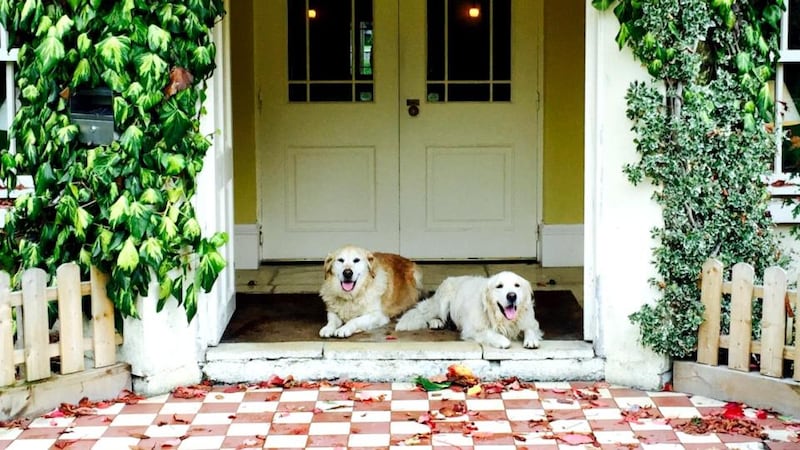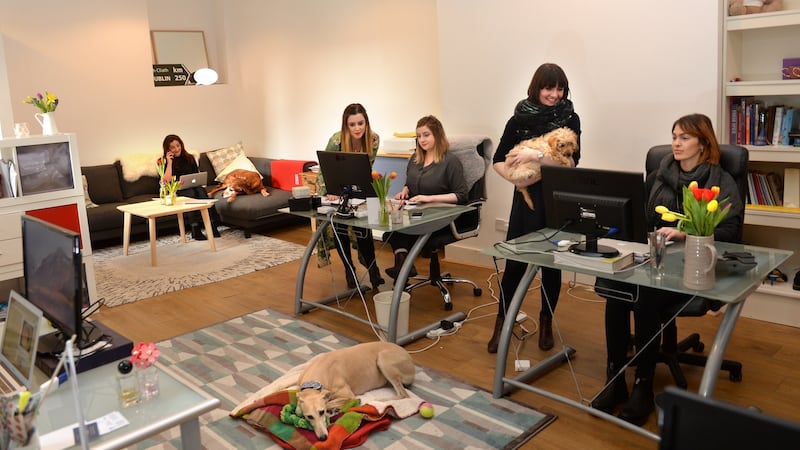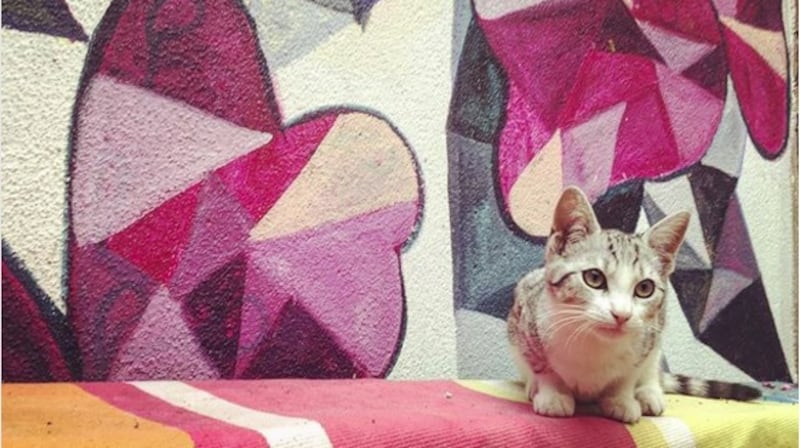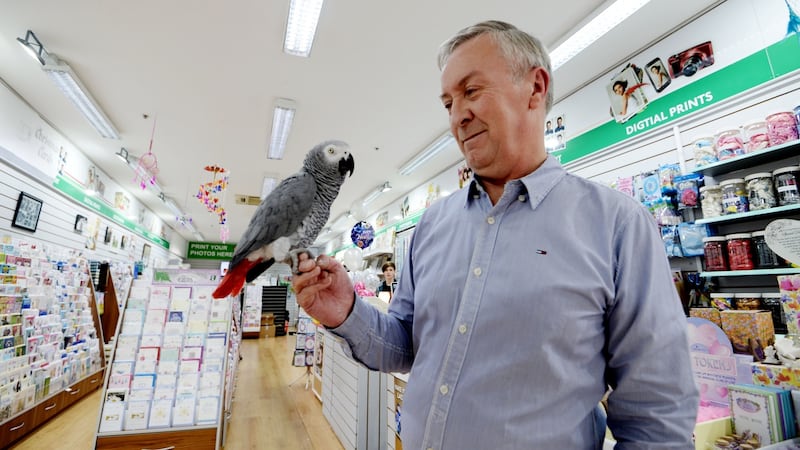The Irish office is a much-changed place of late. The past year has seen the sweeping out of casual sexism, power lunches and after-work drinks. In their place have been empowerment workshops, office yoga and a general redress of the work-life balance. And pets are very much a part of this new workplace culture. Late last year, a law forbidding cats and dogs from pubs and restaurants was repealed, signalling a further shift away from the belief that a pet’s place is in the home (or park).
About 8 per cent of employees in the UK are allowed to take their dogs to work, according to research by Reed.co.uk.
According to research from online job board CV-Library, Irish employers are beginning to see the benefits of allowing their staff to bring their animals to work with them.
Where giants such as Google and Airbnb blazed a trail, other, smaller businesses are following suit. Some 2,000 employees from across the UK and Ireland were surveyed for the research, which revealed that one-fifth of workplaces in Ireland accept pets in the office.
Nearly 40 per cent of Irish workers would like to see more workplaces allowing pets – with 32 per cent even suggesting they’d be more likely to apply for a role in such a company – but 13 per cent maintain that strict policies from HR should be in place.
According to the research, dogs make up 87 per cent of all “professional” pets cited. Only 5 per cent admit to having a cat in the workplace, and rabbits are coming in third at 2 per cent.
Research
Scientists doing research into the effects of bringing dogs to work have made similar observations. In 2012, researchers for the Virginia Commonwealth University in the US studied the stress levels of the staff of a manufacturing company who brought their dogs to work. They found these workers reported feeling significantly less stressed throughout the day than those who did not bring a dog to work.
In another study, carried out by organisational psychologists at Central Michigan University, individuals were placed into groups of four, with and without dogs, and each group member was charged with a fake crime. In groups where there were dogs present, members were 30 per cent less likely to report each other, suggesting dogs promote cohesion and trust among team workers. A further study found team members of groups with dogs rated each other more highly on measures of intimacy, team cohesion and trust than members of groups where dogs were not present.
Boon for business
In Ballincollig, Cork, Brendan Bowe of Bowe Property estate agents has observed that having his weimaraner Ralph in the office is a boon for business. Originally, Bowe brought his other weimaraner, the late Baxter, to work too. He became the company's mascot, and still has pride of place on its website and 'For Sale' signs.
“I remember one elderly couple brought the sale of their house to us, and I’d never dealt with them before,” recalls Bowe. On why they were bringing their business to Bowe, they said, “any man who will put his dog up on his ‘For Sale’ boards is someone we can trust”.
Bowe has been a lifelong dog lover. “I always wanted a dog in my life, and though I was busy, I wasn’t going to let life pass me by. This business entails lots of hours and I made a conscientious decision not to get a puppy and just leave it at home,” he explains. “I discussed it with the girls in the office to make sure there were no objections, and soon he was coming to work every single day.”
Both Baxter and Ralph got to know the clients pretty quickly: “Soon, they were coming in just to see the dogs, not me,” Bowe laughs. “It’s an extraordinary ice-breaker, having a pet around. Within 10 minutes people are opening up to you. I think there’s a real sense of trust – if you care enough about your dog to bring him to work, you must have some sort of decency in you.”
Clocking in at about 45 kilos, weimaraners require a huge amount of exercise; at least two hours of off-leash activity a day. Far from being a hindrance, the requirement encourages Bowe to get fresh air and exercise himself.
More downtime
In Kilkenny, Sara Egan, owner of The Gift Horse art and gift shop, has also incorporated more downtime into the daily grind, thanks to her rescue dog, a 10-year-old smooth fox terrier called Ruby.
“I couldn’t go for a walk unless I had a dog,” she says. “Having a dog makes you more sociable and inclined to get out and about. I live in south Kilkenny, so we drive in to work in the mornings, park on the outskirts of the city, and walk for 20 minutes. It’s a great way to gather your thoughts.”
Ruby was found dumped in the car park off Egan’s father’s restaurant (“you know they’d probably get fed near a restaurant”) and once Egan took her under her wing, she found she had acquired a dog that needed no end of TLC.
“I used to put her out in the back garden and walk in the mornings, at lunchtime and after work, but I could hear her crying as I went up the road,” recalls Egan. “I don’t want to say she’s needy, but she is. Because The Gift Horse is my own shop, I can tuck her in behind the counter. When customers see her, it’s a real source of amusement. You have to create a really relaxed atmosphere, and a dog like Ruby certainly adds to that.”
Friendly welcomes
Anyone who has been to BrookLodge Hotel in Wicklow, meanwhile, is likely to remember the feeling of serenity and calm once over the threshold. Much of this has to do with the near-iconic golden retrievers slumbering next to the front desk. Owner Evan Doyle, who lives on the Macreddin grounds, usually brings Oscar (14) and George (8) to the hotel, where they preside over events in the reception, accounts office and lounge. Before them there were other golden retrievers – Lily, Oscar and Rudy. Also in the mix is Missy, owned by maintenance manager Eugene Giblin. They may leave paw prints on the floor tiles and BrookLodge's staff may need to hoover more often than they might like, but the pay-off, Doyle says, is immense.

“Golden retrievers have a really nice temperament, and the guests and crew are safe with them,” explains Doyle. “I have hens and ducks roaming the grounds and the dogs never run after them. And guests just know, once they walk in through the door, that they’re in a country house hotel. They just set the tone perfectly.”
Elsewhere, on Dublin's bustling South William Street, dogs rule the roost at Host PR. The elder lemon, a labrador/red setter cross, Bishop (13), is owned by managing director Tim Magee.
It certainly helps to foster a pet-friendly workplace from the top down. Magee strived to make his office amenable for employees’ dogs, and now Flee, a lurcher, and Sadie, a three month-old cockapoo owned by account manager Breffni O’Dwyer, are office regulars.

“Luckily we’re all mad dog lovers here,” observes O’Dwyer. “Sadie is very cute and busy. She was stealing gloves out of people’s bags, but she’s getting a little bit better. There have been a few mishaps as I’ve been trying to toilet train her, but you just clean up and move on.”
Cohesive workforce
Bonding over pets has created a more cohesive workforce, too: “Every day we have a 15-minute meeting, where we go through any issues or updates, and Tim will say, ‘now, update me on Sadie’,” says O’Dwyer. “It makes for a happier team.
They kind of remind everyone that there's more to the world than work
“You’re definitely more relaxed. They kind of remind everyone that there’s more to the world than work, as serious about your job as you are. When you’re working away and hitting deadlines and it’s a full-on day, there’s this 13-year-old dog lying in the corner, lying like a roast chicken – it’s pretty good for diffusing any tensions that you might have.”
Sadie has become a popular fixture on Instagram, and is now followed by several colleagues and clients ("it means that others see a little bit more of you as a person", notes O'Dwyer). And over at La Catedral artists' studios, 10-month old cat Ophelia, named by her owner and studio co-founder Antonella Scanu after the recent storm, is a regular both in the studio and on the photo-sharing site (as @artstudiocat).
“I had always wanted a cat and thought she could be looked after on a shared basis in the studios,” explains Scanu. “When I saw her I fell in love and the damage was done.”

Cats, however, are rather territorial creatures of habit and, in the main, not necessarily amenable to change, busy spaces or crowds. In this respect, Ophelia is an exception to the rule.
“She loves being around people. The artists in the studio are like a big family so she knows everybody now and she is perfectly at ease,” says Scanu. The space caters for more than 40 artists, but it’s not a chaotic space. The studios consist of two very spacious lofts, which allow plenty of space for the cat to roam about, run, climb and play as she pleases.
“I’d highly recommend bringing a cat to the workplace,” she adds. “The positive effects are countless. She gives more pleasure than the work it takes to look after her. Generally speaking, cats need enough space to climb, a comfy and warm spot to rest, people to interact with and a lot of patience for possible mishaps – side effects may involve some scratched pieces of furniture, distraction from work and misplaced random objects. In general though, she seems to get away with a smile.”
A northside parrot
At Northside Shopping Centre, those who pass by Northside Photo Centre’s window are used to seeing Pixie, a 13-year-old parrot.
His owner, Paul Barr, has always loved living with exotic birds. When the time came for him to open his own shop, he decided to bring his pet Pixie (and before him, Odo) to work. His vet was in agreement that the workplace would be a good fit for parrots, and so Pixie does a daily commute with Barr.

“Parrots are very intelligent and need a lot of stimulation,” he says. “I couldn’t leave him at home. Every morning, I take Pixie out and put him in his perch, he hops onto my hand. When it’s bedtime, he clings to my hand and won’t go into the cage. He actually looks forward to going to work; he gets moody if we have a day off.”
In the shop, Pixie is a charmer who laughs with children and flirts with female customers. “In the morning I leave him beside the [window] grille, and he loves to sit there and say good morning to people. Yet, with intelligence comes a temperament, so he comes in behind the window when the shops open.
“I find it helps to remind me that life is not all about the buck. It’s about people, and my business, in particular, is about hearing people and their stories.” If anything, the problem is that Pixie needs to go on a diet: “He’s a little overweight because people give him nuts and food when my back is turned. They’re killing him with kindness.”
Of those considering broaching the idea of bringing a pet to work with bosses and colleagues, Egan advises: “I’d give it a trial at least. It’s not for every pet. Maybe try it out for blocks of time. But having a dog sitting with you for the entire working day is not a goer.”
Adds Bowe: “Fundamentally, your pet needs to be sociable. You have to be hugely respectful that not every colleague is comfortable with dogs. He may the focus of your life, but it’s not for everyone.”
Doyle agrees: “There are certain workplaces that pets suit. I wouldn’t be bringing them into a nuclear plant, say. You wouldn’t know what switch they might press.”










